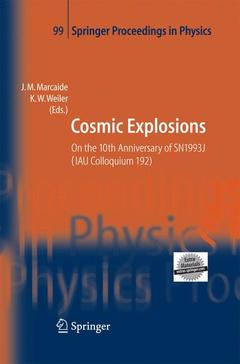Cosmic Explosions, 2005 On the 10th Anniversary of SN1993J (IAU Colloquium 192) Springer Proceedings in Physics Series, Vol. 99
Langue : Anglais

Supernovae are among the most energetic phenomena in the Universe and - lated to almost all aspects of modern astrophysics including starburst gal- ies, cosmic ray acceleration, neutron star and black hole formation, nuc- osynthesis and ISM chemical enrichment, energy input to the ISM, cosmic distance scale determination, dark energy related cosmological acceleration, gamma-ray bursts, extra-solar system neutrino burst detection, gravity wave generation, and many more. Additionally, the past 15 years have been p- ticularly productive with many new results and new understanding due in particular to the closest SN in 400 years in SN 1987A in the Large M- ellanic Cloud, and the unusually bright and close SN 1993J and SN 1994I in the nearby galaxies M81 and M51, respectively. In addition, the disc- ery of the ?-ray burst GRB 980425 and its related supernova SN 1998bw, and the con?rmation of GRB 030329/SN 2003dh, tied the study of SNe and GRBs inextricably together. With the many developments since the last - jor supernova meeting in La Serena, Chile in 1997, we felt that it was an appropriate time to bring together experts and students interested in the subject for a meeting where SN and GRB properties and interrelationships could be discussed. The tenth anniversary of SN 1993J provided such an - portunity and, appropriately, the meeting was held in Spain where SN 1993J was discovered on the early morning of 28 March 1993 by a Spanish amateur astronomer, Francisco Garc? ?a.
Supernovae: Individual.- A Decade of Radio and X-ray Observations of SN 1993J.- Imaging of SN 1993J.- Nine Years of VLBI Imaging of Supernova 1993J.- On the SN 1993J Radio Shell Structure.- Optical, Ultraviolet, and Infrared Observations of SN 1993J.- Simulated Radio Images and Light Curves of SN 1993J.- X-ray Observations of SN 1993J.- Modeling the Radio and X-ray Emission of SN 1993J and SN 2002ap.- Detection of the Binary Companion to the Progenitor of SN 1993J.- Supernova 1987A: The Birth of a Supernova Remnant.- SN 1987A at Radio Wavelengths.- High-Resolution Radio Imaging of Young Supernovae: SN 1979C, SN 1986J, and SN 2001gd.- VLBI Observations of SN 1979C and SN 1986J.- SN 1994W: Evidence of Explosive Mass Ejection a Few Years Before Explosion.- A Most Energetic Type Ic Supernova: SN 2003L.- Radio Monitoring of Supernova 2001ig: The First Year.- Synthetic Spectra of the Type Ia SN 2002bo.- Supernovae: Observations.- Radio Supernovae.- Low Frequency Radio and X-ray Properties of Core-Collapse Supernovae.- Supernova Spectra.- Optical Spectroscopy of Type Ia Supernovae.- The Early Spectroscopy of Supernovae.- Optical Light Curves of Supernovae.- Late Light Curves of Type Ia SNe.- Photometric Observations of Recent Supernovae.- Observational Properties of Type II Plateau Supernovae.- X-ray Spectra of Young Supernovae.- Supernovae: Progenitors/Remnants.- Pre-Supernova Evolution of Rotating Massive Stars.- Radiation Bursts from a Presupernova Collapsar.- Radio Observations of Supernova Remnants in the M82 Starburst.- Deep Radio Imaging with MERLIN of the Supernova Remnants in M82.- Thermonuclear Supernova Explosions and Their Remnants: The Case of Tycho.- Supernovae: Models.- Models of Supernova Explosions: Where Do We Stand?.- Core-Collapse Supernovae at the Threshold.- Two New Possible Mechanisms of Supernova-Like Explosions.- Tests for Supernova Explosion Models: from Light Curves to X-ray Emission of Supernova Remnants.- Understanding Type II Supernovae.- Magnetorotational Mechanism of Supernova Type II Explosion.- Nucleosynthesis in Black-Hole-Forming Supernovae.- Nucleosynthesis in Multi-Dimensional Simulations of SNII.- 56Ni Mass in Type IIP SNe: Light Curves and H? Luminosity Diagnostics.- Effects of Small-Scale Fluctuations of Neutrino Flux in Supernova Explosions.- Neutrino Gas in Equilibrium with Self-Interaction.- Weak Interaction Processes in Core-Collapse Supernovae.- Synthetic Spectra for Type Ia Supernovae at Early Epochs.- On the Stability of Thermonuclear Burning Fronts in Type Ia Supernovae.- Explosion Models for Thermonuclear Supernovae Resulting from Different Ignition Conditions.- Supernovae: Searches/Statistics.- Supernova Statistics.- The Infrared Supernova Rate.- The Rate and the Origin of Type Ia SNe in Radio Galaxies.- Supernovae in Galaxy Clusters.- Using Multi-Band Photometry to Classify Supernovae.- Supernova and Gamma-Ray Burst Connections.- Optical and Near-IR Observations of SN 1998bw.- SN 1998bw and Other Hyperenergetic Type Ic Supernovae.- The Supernova/GRB Connection.- Optical Bumps in Cosmological GRBs as Supernovae.- Long GRBs and Supernovae from Collapsars.- How Common are Engines in Ib/c Supernovae?.- Gamma-Ray Bursters.- Cosmic Gamma-Ray Bursts: The Big Picture.- The Surroundings of Gamma-Ray Bursts: Constraints on Progenitors.- The Radio Afterglows of Gamma-Ray Bursts.- Gamma-ray Bursts.- X-ray Emission from Gamma-Ray Bursts.- Particle Acceleration in Gamma-Ray Bursts.- The First Steps in the Life of a GRB.- Physical Restrictions to Cosmological Gamma-Ray Burst Models.- Dynamical Evolutionof ?-cooled Disks Following Compact Binary Mergers.- On the Central Engine of Short Gamma-ray Bursts.- Supernovae, Gamma-Ray Bursters, and Cosmology.- The Expanding and Accelerating Universe.- Observations of Type Ia Supernovae and Challenges for Cosmology.- The Standard Candle Method for Type II Supernovae and the Hubble Constan.- Observing the First Stars, One Star at a Time.- The Host Galaxies of High-Redshift Type Ia Supernovae.- Constraints on SN Ia Progenitors and ICM Enrichment from Field and Cluster SN Rates.- Expected Changes of SNe with Redshift due to Evolution of Their Progenitors.- Dark Energy: Nature and Robustness.- Brane Universes Tested by Supernovae.- A Geometric Determination of the Distance to SN 1987A and the LMC.
Includes supplementary material: sn.pub/extras
Date de parution : 11-2014
Ouvrage de 593 p.
15.5x23.5 cm
Date de parution : 11-2004
Ouvrage de 593 p.
15.5x23.5 cm
Thème de Cosmic Explosions :
Mots-clés :
Cosmology; Redshift; Universe; gamma-ray bursts; stellar candles; supernovae
© 2024 LAVOISIER S.A.S.



